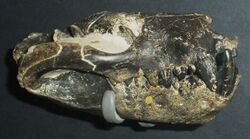Biology:Borhyaena
From HandWiki
Short description: Extinct genus of mammals
| Borhyaena | |
|---|---|

| |
| B. tuberata skull | |
| Scientific classification | |
| Domain: | Eukaryota |
| Kingdom: | Animalia |
| Phylum: | Chordata |
| Class: | Mammalia |
| Order: | †Sparassodonta |
| Family: | †Borhyaenidae |
| Genus: | †Borhyaena Ameghino 1887 |
| Species | |
| |
| Synonyms | |
| |

Borhyaena is an extinct genus of South American metatherian, living between 17.5 and 15.5 million years ago in Patagonia, Argentina (Santa Cruz and Sarmiento Formations) and Chile (Río Frias Formation).[2]
Description
Borhyaena was a predator and had a large head and a long, powerful neck similar to living hyenas. Its legs were cursorial, albeit less specialized than those of wolves or the marsupial thylacine. The most complete specimen is estimated to have weighted 23 kilograms (51 lb) and stood 50 centimetres (1.6 ft) at the shoulders.[3]
References
- ↑ Marshall, Larry G. (1978). Evolution of the Borhyaenidae, extinct South American predaceous marsupials. 117. University of California Press. pp. 1–89.
- ↑ Borhyaena at Fossilworks.org
- ↑ Argot, C. (2003). "Functional adaptations of the postcranial skeleton of two Miocene borhyaenoids (Mammalia, Metatheria), Borhyaena and Prothylacinus, from South America.". Palaeontology 46 (6): 1213–1267. doi:10.1046/j.0031-0239.2003.00339.x.
External links
Wikidata ☰ Q266325 entry
 |

